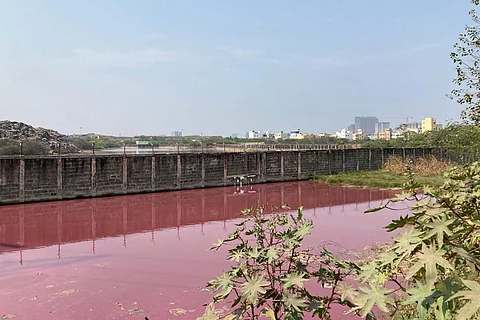

Residents in Chennai’s Perungudi have a new cause for alarm. Just days after the massive fire in the dumpyard in the locality was doused, the lake adjoining the landfill has turned pink. Situated next to the 200-feet Radial Road, the pink-coloured lake has now become a ‘photo booth’ to passers-by.
G Janardhan, Associate Professor, Department of Civil and Environmental Engineering, National Institute of Technical Teachers’ Training and Research (NITTTR), says that the “pink lake” phenomenon is due to the presence of cyanobacteria. “This is an algal bloom, usually found in water bodies that are contaminated with methane as a result of industrial waste being dumped into the water. But here we don’t have any industries, still the colour of the water turned pink because of the leachate. This happened two years back also. Our team members will soon collect samples to study and analyse the impact.” His team from NITTTR has been researching the Perungudi dumpyard for more than a decade to understand the land characteristic changes.
The lake water has turned pink due to methane contamination (TNM photo by Bharathy Singaravel)
“We dump waste in marshlands, and when organic waste decomposes in the absence of oxygen, it generates methane which is inflammable and is often behind dumpyard,” says environmentalist Nithyanand Jayaraman. “We don’t have to wait for a waterbody to turn pink to know the degradation of the ecosystem. The dumpyard has already destroyed the entire marshland,” he adds.
Cyanobacterial algal bloom on the surface reduces the oxygen level in a waterbody. It blocks sunlight from reaching the flora and fauna. Without sufficient sunlight, plants cannot grow properly and living organisms in the water will starve to death. An algal bloom can be harmful when it releases toxins into the air and water. High concentration levels of such toxins are dangerous to the environment as well as to human beings.
After a huge fire broke out on the night of April 27 in the 225-acre Perungudi dumpyard, it took three days of struggle for the Greater Chennai Corporation (GCC) to extinguish the flames. The municipal dumpyard was overflowing with around 3.63 million cubic metres of waste when the incident took place. Thick toxic fumes from the burning garbage spread over a 6 km radius, affecting residents in several parts of the city, including Velachery, Besant Nagar, Adambakkam, Guindy and others.
Also read: